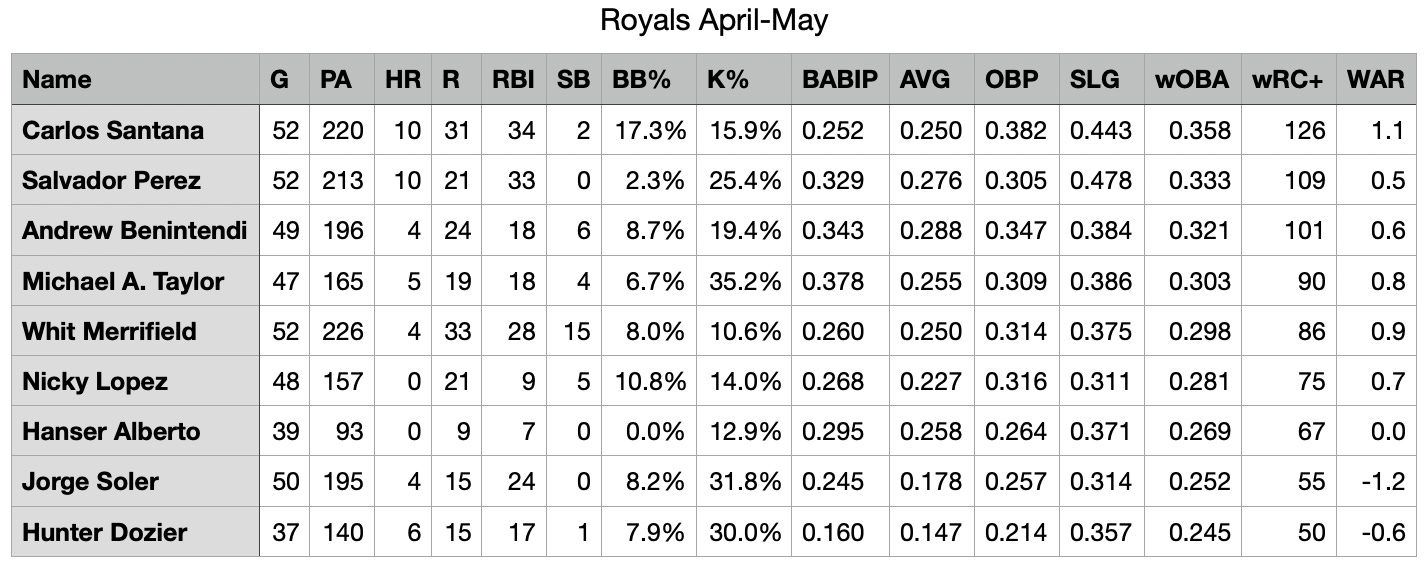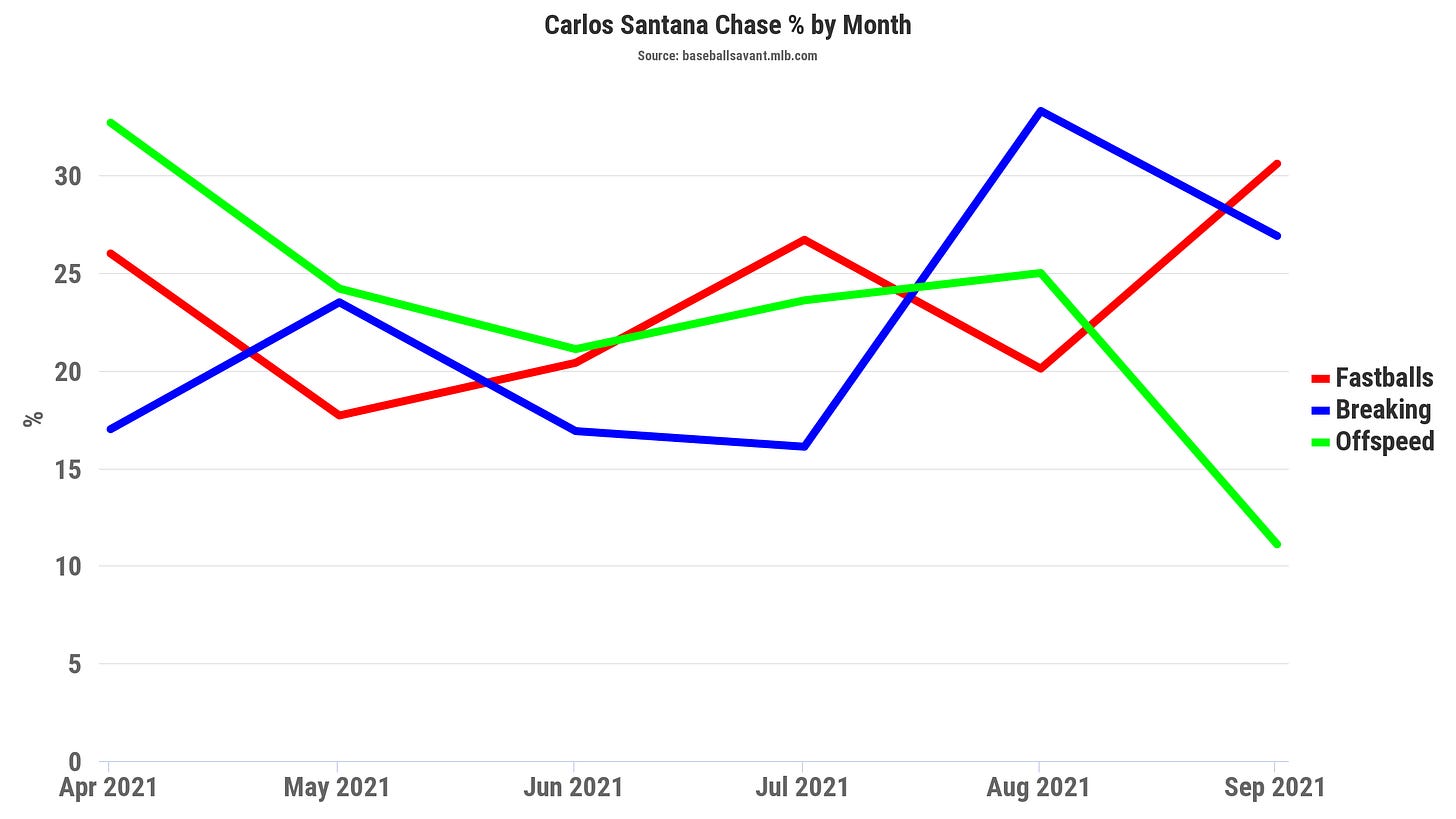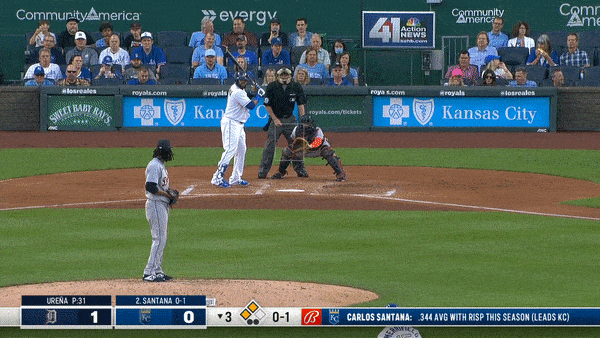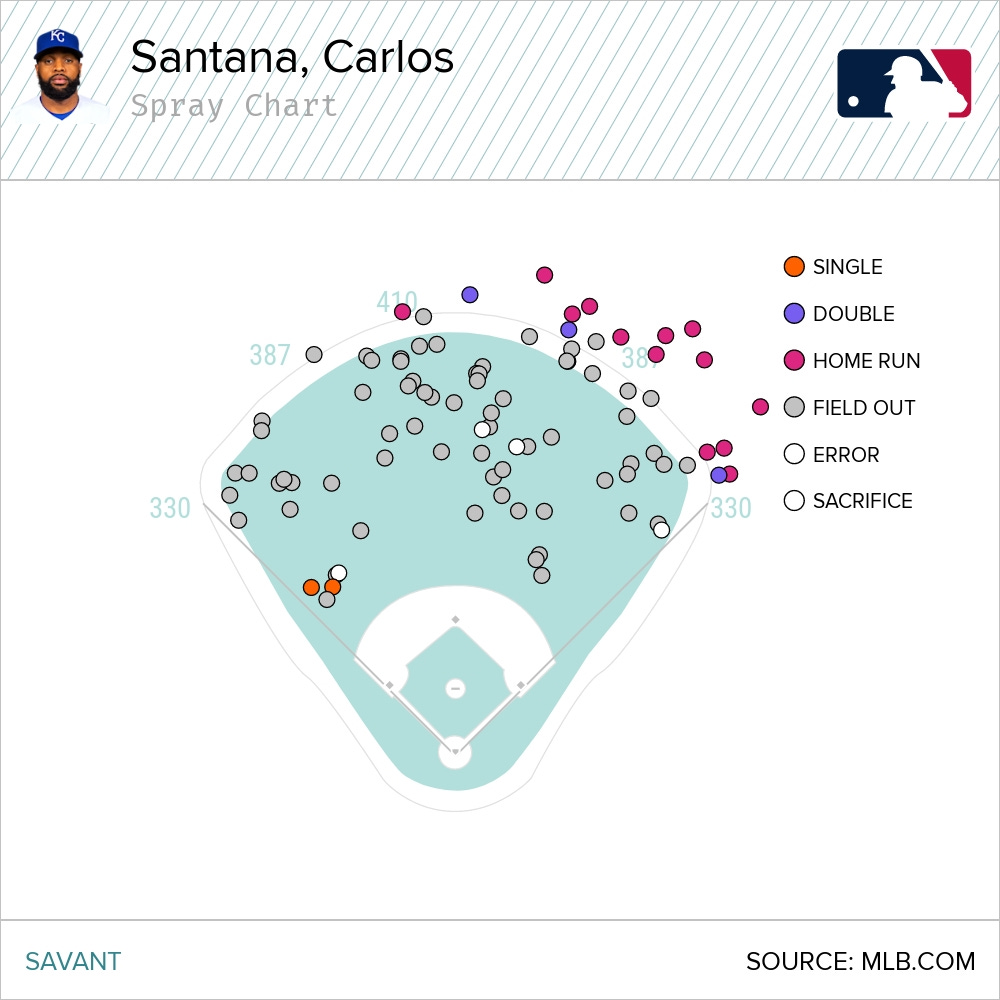The decline and fall of Carlos Santana
The Royals had high hopes when they brought Carlos Santana into their lineup. Things haven't gone as planned and the future appears awfully grim.
Carlos Santana has had a confounding season. It’s easy to forget through the first two months of the season, the newly-signed first baseman was the most productive hitter in the Royals lineup.
Santana was walking more than he was whiffing. He led the team in OBP and was second to Salvador Perez in slugging. His 126 wRC+ was by far the best mark on the team. As it was shaping up for another ho-hum offensive season for the Royals, Santana represented a true bright spot. A player whose presence definitely lengthened the lineup.
In the three-plus months since the production has evaporated.
From the top of the pile to the bottom of the heap. It’s been just an epic collapse.
He’s walking, but at a much lower rate. That has meant his OBP cratered. Most troubling, his slugging has completely dried up and represents the worst mark on the club since the start of June. He was worth 1.1 fWAR in the first two months of the season. He’s given it all back, with a -1.1 fWAR since.
Expanding the zone with aggression
Santana has become a much more aggressive hitter at the plate as a Royal. This year, he’s swinging at 43.4 percent of all pitches he sees, an increase of over seven percent over his abbreviated 2020 season and almost four percent more than he offered at pitches in 2019, a year that ranks among the most productive of his career.
The aggressive approach was on display immediately. It dropped a little bit in May, but was still above what we’ve seen from Santana in his career. He held steady in June, but as his slump deepened (Santana hit .220/.322/.340 with a wRC+ of 81 in the month of June) his aggression at the plate only increased. He’s swung at a higher rate of pitches in the last two months than at any time, save April—when the approach actually worked for him.
This has caused two problems.
One, as Santana has become less selective, he’s getting fewer of his pitches to hit. Thus, his overall quality of contact has declined. According to Baseball Savant, Santana has connected on the sweet spot 27.5 percent of the time. That’s below his career rate of 29 percent and well below the MLB average of almost 33 percent.
This has meant a decline in his hard-hit rate.
While July was his best month at tagging the baseball, Santana posted a frustrating .227 BABIP for the month, meaning he had little to show for a stretch where he was really making contact with pitches. So he became even more aggressive in August with predictable results.
It’s basically a hitting spiral of death. Santana assumes a more aggressive approach at the plate, but doesn’t see results despite stinging the baseball. So he becomes even more aggressive but now he’s not hitting the ball near as hard.
His drop in hard-hit rate is mirrored by an alarming increase in chase rate. Santana has seemingly grown frustrated and has decided the solution to his ails is to swing with greater frequency—at pitches both in and out of the strike zone.
The other problem this has caused is a decline in his walk rate. Sure, there’s a joke somewhere in there that only the Royals could bring Carlos Santana’s walk rate down below 14 percent. He’s currently drawing a free pass 12.8 percent of the time. That’s still a good rate, but given Santana’s track record, that’s more abysmal than anything else. Santana has walked in over 15 percent of his plate appearances in his career. He posted an 18 percent walk rate last year.
While Santana’s power had been in semi-steady decline since he turned 30 (the exception being his 2019 season), he maintained a semblance of value through his on base percentage which was achieved via the free pass. With the continued (and really, expected) decline of his power, if Santana isn’t walking close to his career rate, his value is…well, we’re staring a 0.0 fWAR season right in the face.
Sticking it to Santana with the shift
One can’t discuss Santana’s 2021 season without mentioning the shift.
When Santana hits from the left side, the infield defense is deploying the shift 97.3 percent of the team. If that seems like a lot…IT IS! The left-handed-hitting Santana is the most shifted hitter in the majors this year.
When a batter is shifted that much, it’s useless to compare the shifted results versus the unshifted. This is simply how it is when Santana is up there left-handed. With data going back to 2016 at Baseball Savant, we can see how frequently the shift has been deployed against Santana when he hits lefty.
2016—66.5%
2017—76.2%
2018—85.5%
2019—82.4%
2020—96.3%
2021—97.3%
The 2019 season aside, it’s been a gradual increase year over year in the shift when Santana is up there from the left side. Let’s see how that relates to his overall production as a left-handed batter.
It’s interesting that his production from the left side has declined each season he’s seen an increase in the shift. Only the 2019 season is the outlier. Of course, some of this could be a coincidence. Santana turned 30 in 2016 so it wouldn’t be crazy to expect some kind of decline in offensive production. It could be that it just so happens that it has coincided with an increase in the shift. Or it could be that the shift has hastened the inevitable.
This is the average positioning for fielders when Santana is at the plate from the left side.
It’s not an accident that defenses are aligning that way when Santana hits as a lefty. This is his spray chart on ground balls in 2021 when Santana has been up as a left-handed hitter.
He’s beat the shift a couple of times by going to the left side, but that’s not happening often. The cluster of hits on the edge of the infield grass where the shortstop would be positioned in a normal alignment caught my eye. In the shift against Santana, there’s usually a defender in that spot. But not always.
When a runner is on second, that forces the third baseman to stay anchored to his position. That opens up a huge gap between infielders. It should be mentioned that for Santana to hit the ball on the ground to the opposite field, he needs to have that pitch run way off the outside corner. The plus side is a ground ball in that spot with a runner on second it’s going to result in an RBI.
Still, that outcome is a rarity. And it’s not going to change.
The power outage completes the collapse
As Ben Clemens noted last week at Fangraphs, Santana is getting a high percentage of fastballs down the chute…and is failing to capitalize. He’s become unable to turn on the heater, no matter the side he’s hitting from.
Clemens focused exclusively on fastballs, but I’ll look at how Santana has done against every pitch. When Santana has gotten the ball in the air as a left-handed batter, he’s hitting it to all fields. The home run production comes from when he pulls the ball.
Flip to when Santana hits from the right side and the power has completely gone. He’s slugging just .373 against left-handed pitching this year. It’s because he can’t get around on any pitch when he hits from the right side.
A good rule of thumb is that for a hitter’s power production, 75 percent of that comes from when he pulls the ball. That’s just where the power resides. But when you’re not pulling balls in the air…the power is going to decline. Especially when you’re on the wrong side of 30.
Santana had a stretch of 144 plate appearances between dingers. That ran from July 24 to September 4. Even for a hitter with declining power, that’s an incredible stretch.
He hit another dinger three games later, giving hope that he was plugged back in and it would be just a matter of time before the power was surging. At least a little bit. Alas, September is looking like the previous three months. After all of this, Santana is currently hitting .218/.320/.360. Each number of the slash is the lowest he's been for that mark since early April when the sample sizes are small but the hope is large.
Where do the Royals go from here?
I had hoped Santana’s dismal 2020 was just a blip. A Covid-shortened forgettable season where nothing was normal. It turns out that was just a small sample harbinger.
As outlined above, his decline feels very real, with little hope for a turnaround. Sure, he could recapture some form and produce closer to league average production, or have brief spurts of productivity like we saw in the first couple months of the season, but patience will be thin. Especially given what the franchise has percolating in the minors with Nick Pratto looking ready for a major league opportunity. However, Santana represents an immoveable object in the Royals’ lineup. Next year, he’s due to make $10.5 million, which is the second-highest commitment to a player currently on the books for 2022. Where there was perhaps some value at the trade deadline, Santana has played himself into an untradeable commodity.
He’s an expensive roadblock.
It was a good gamble at the time. The Royals needed a first baseman at the major league level, probably for the next two years. Santana, coming off that shortened season where his productivity cratered, represented a bargain and potential fit. Now with Pratto pressing for time and Santana struggling at the plate it was a gamble the Royals didn’t win.














